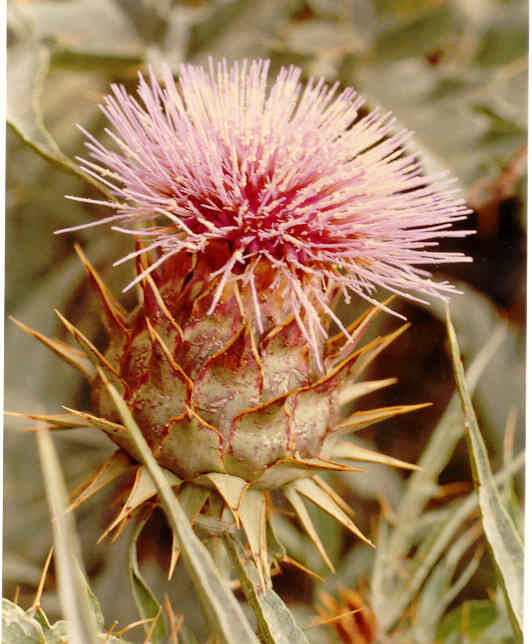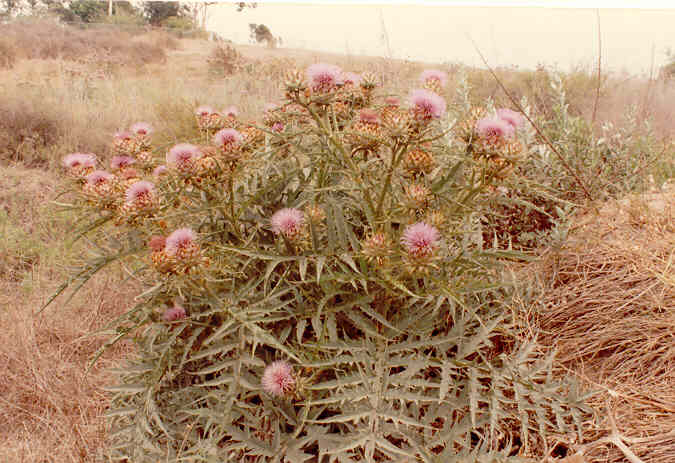
Cynara cardunculus L.
Asteraceae (Sunflower Family)
Medit. Region
Artichoke Thistle
Cardoon
 |
Cynara cardunculus L.Asteraceae (Sunflower Family)Medit. Region
Artichoke ThistleCardoon
|
June Photo
Plant Characteristics:
Robust, freely branched perennial herb, 5-10 (-20) dm. high; stems and
under side of lvs. white-tomentose, the upper side of lvs. grayish-green, +/-
arachnoid; lvs. 3-6 dm. long, deeply pinnatifid, prominently spiny; invol. 3-6
cm. high, 4-7 cm. diam., narrowed above; phyllaries spine tipped; heads +/- 5
cm., purple-fld., solitary; pappus of many series of plumose bristles; aks.
thick, glabrous, compressed or 4-angled, with truncate apex.
Habitat:
Occasionally naturalized in low places, as in Orange Co. and cent. Calif.
May-July.
Name:
Greek, kuon, dog, the invol.
spines likened to dog's teeth. Greek,
kardos, a thistle; also, Latin carduus,
a thistle. (Jaeger 47). Latin, ulus,
adjective suffix meaning small. Thus
cardunculus, small thistle, but
cardoon is hardly small compared to most thistles.
(John Johnson).
General:
Common in the study area. Very
common in the Santa Ana Heights area near the Delhi Ditch.
Photographed on the Santa Ana Heights Flats, the North Star Bluffs.
(my comments). Artichoke thistle was introduced into the
area near Benicia about fifty years ago. Probably
it was imported from southern Europe where it was used as food.
It escaped from the gardens where it was first planted and spread over
some 70,000 acres in and around Benicia and Cordelia.
The plant had spread over the hills into the areas which were formerly
used for grain to such an extent that the forage had been made useless.
Due to the spiny nature and spreading habit of the plant, cattle and
sheep will not venture through thick infestations.
Frequently, in order to save moving stock around a large, heavily
infested area, it has been necessary to cut trails through.
The infestations in and around Benicia and Cordelia have been largely
eradicated in the last few years. (Robbins
et al. 458). (Robins,
et al. was first published in 1922 with reprints through 1970 so it is unclear
what date the artichoke thistle was introduced near Benica).
(my comments) The
Cardoon, is one of the largest and most delicious of the thistles.
It is the plant from which the cultivated artichoke was derived. (Clarke
221). Using
the herbicide Rodeo and with the blessing of the Fish and Game Dept. and the
Orange County Harbors Beaches and Parks I have, between 1997 and 2000, nearly
eradicated this plant from the bluffs and low lying areas of the Upper Bay. Some
areas in Santa Ana Heights were so heavily infested that the plants were a solid
mass covering areas a large as a half acre.
(my comments).
About 12 spp. of Medit. region and Canary Ids.; 2 grown as vegetables.
(Munz, Flora So. Calif. 154).
Text Ref: Hickman, Ed. 245; Munz, Calif. Flora 1273; Munz, Flora So. Calif. 154; Robbins et al. 458; Roberts 10.
Photo Ref:
Jan 2 84 # 14; June 1 84 # 18,19.
Identity: by R. De Ruff, confirmed by G. Marsh.
Computer Ref: Plant Data 165.
No plant specimen.
Last edit 9/25/02.
 |
June Photo